Oseltamivir,以Tamiflu品牌出售,是一种抗病毒药物,用于治疗和预防A型和B型流感。[3]许多医疗组织向有并发症或在感染首发症状后48小时内有高并发症风险的人推荐使用这种药物。[4]他们建议使用它来预防高危人群的感染,而不是一般人群。[4]疾病控制与预防中心(CDC)建议临床医生根据自己的判断,对那些在出现首次感染症状后48小时内出现的低危人群进行治疗。[4] [5] [6]可以口服,可以是药丸或液体。[3]
关于奥司他韦的建议和对建议的批评都引起争议。[4] [7] [8] [9] 2014年的《 Cochrane评论》得出结论,奥司他韦不能降低住院率,也没有证据表明流感并发症的发生率降低。[9]两项荟萃分析得出的结论是,那些健康的人所获得的收益不会超过其风险。[10] [11]他们还没有发现关于高危人群中治疗是否会改变住院或死亡风险的证据。[10] [11]然而,另一项荟萃分析发现,奥司他韦在个人和家庭层面均能有效预防流感[12]。
常见的副作用包括呕吐,腹泻,头痛和睡眠困难。[3]其他副作用可能包括精神症状和癫痫发作。[3] [13] [14]在美国,建议在怀孕期间进行流感感染。[1]少数孕妇服用了它,没有出现问题的迹象。[1]肾脏疾病患者可能需要调整剂量。[3]
Oseltamivir于1999年在美国被批准用于医疗。[3]它是第一种可通过口腔获得的神经氨酸酶抑制剂。[15]它在世界卫生组织的基本药物目录中,这是卫生系统中所需的最安全,最有效的药物。[16]通用版本于2016年在美国获得批准。[17] [18]截至2014年,发展世界的批发成本约为每天4.27美元。[19]截至2019年,美国一个疗程的批发成本约为54.00美元。[20] 2016年,它是美国处方药排名第249位,处方超过一百万。[21]

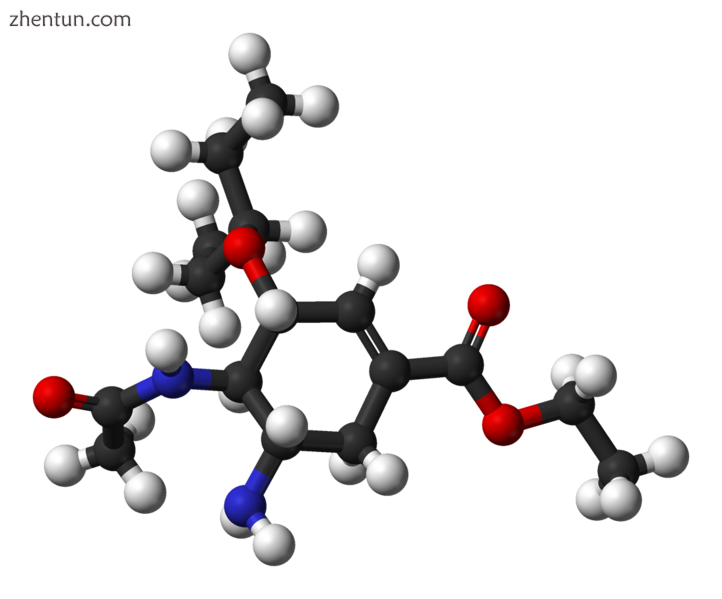
临床资料
内容
1 医疗用途
1.1 高危人群
1.2 健康的人
1.3 预防
2 副作用
3 作用机理
4 抗性
4.1 H1N1流感或“猪流感”
4.2 季节性流感
4.3 H3N2
4.4 乙型流感
4.5 H5N1禽流感“禽流感”
4.6 H7N9禽流感
5 药代动力学
6 历史
7 兽医用途
8 参考
医疗用途
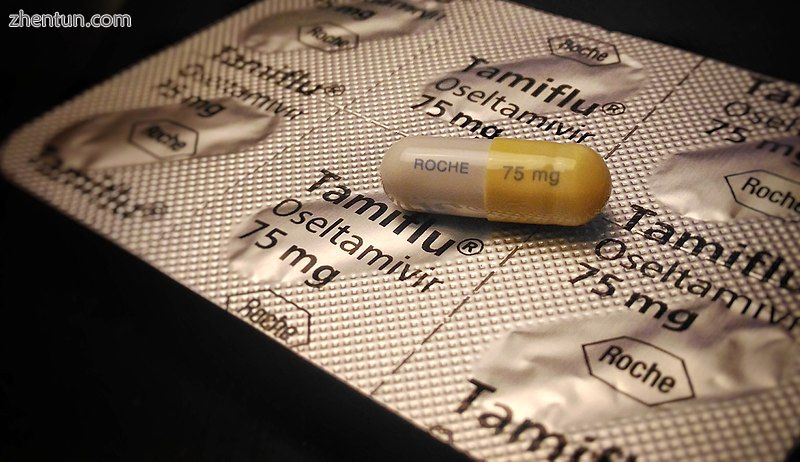
奥司他韦胶囊
奥瑟他韦用于预防和治疗由甲型和乙型流感病毒引起的流感。[3] [22]它在世界卫生组织的基本药物目录中,这是卫生系统中所需的最安全,最有效的药物。[16]世卫组织支持将其用于已确诊或怀疑住院的危重患者中已确诊或怀疑的流感病毒感染引起的严重疾病。[16]奥司他韦的风险收益比是有争议的。[8] [9] 2017年,由于成本效益较低,它已从核心列表移至补充列表。[23]
高危人群
美国疾病控制与预防中心(CDC),欧洲疾病预防与控制中心(ECDC),英格兰公共卫生和美国儿科学会(AAP)建议对有并发症或高危人群使用奥司他韦并发症。[4] [5] [24] [25] [26]其中包括那些住院的儿童,年幼的儿童,65岁以上的儿童,其他有严重健康问题的人,怀孕的人以及美洲土著人民。[24]美国传染病学会的立场与疾病预防控制中心相同。[7]
对《公共科学图书馆·手册》的系统评价的系统评价并未发现有风险人群受益的证据,并指出“该试验的设计或能力不足以提供有关严重并发症,住院和死亡率的结果”,[10] 2014年Cochrane评论。[27] 《 Cochrane评论》进一步建议:“根据这次审查的结果,临床医生和医疗保健政策制定者应紧急修订目前对流感患者使用神经氨酸酶抑制剂(NIs)的建议。” [27]用于预防或治疗的NIs“基于这些发现,似乎没有证据表明患者,临床医生或政策制定者可以使用这些药物预防每年的流感和大流行性流感爆发中的严重后果。” [27]
CDC,ECDC,英格兰公共卫生,美国传染病学会,AAP和Roche(发起人)拒绝接受Cochrane审查的结论,部分理由是该分析不适当地形成了对那些认真对待人的结果的结论。根据主要在健康人群中获得的结果得出的疾病结果,并且该分析不适当地包括未感染流感的人的结果。[4] [5] [7] [25] [26] EMA并未因Cochrane研究而更改其药物标签。[28]
2014年在《新英格兰医学杂志》上发表的一篇评论建议,在流行性感冒爆发期间被确诊为社区获得性肺炎的所有重症监护室患者,应接受奥司他韦治疗,直到通过PCR检测确定没有流感感染为止。[29]
2015年的系统综述和荟萃分析发现,奥司他韦对治疗流感症状,缩短住院时间和减少中耳炎的风险有效。同一篇评论发现奥司他韦不会显著增加不良事件的风险。[30] 2016年的一项系统评价发现,奥司他韦稍微减少了缓解流感症状所需的时间,而且还增加了“成人恶心,呕吐和(和)精神病事件以及儿童呕吐的风险”。[31 ]疾病持续时间减少了大约18小时。[32]
健康的人
CDC指出,在其他方面健康的人中,可以在头48小时内考虑使用抗病毒药。[24]德国的临床实践指南建议不要使用它。[33]
2013年的两项荟萃分析得出的结论是,那些健康的人所获得的收益不会超过其风险。[10] [11]当分析仅限于已确诊感染的患者时,Cochrane评估发现不清楚的证据表明发生诸如肺炎等并发症的风险发生了变化,[27]而其他三项评估则发现风险降低了。[11] [34] [35]总之,已发表的研究表明,奥司他韦可将症状持续时间缩短0.5-1.0天。[36]治疗的任何益处都必须与副作用(包括精神症状和呕吐率增加)进行权衡。[14]
2014年的Cochrane合作评论中得出结论,奥司他韦不影响住院治疗,并且由于缺乏诊断定义或病毒传播减少,因此没有证据表明流感并发症(如肺炎)减少。也有证据表明,奥司他韦可以阻止某些人产生足够数量的自身抗体来抵抗感染。作者建议对指南进行修订,以考虑到利益少和伤害风险增加的证据。[27] [37]
美国疾病预防控制中心(CDC),欧洲疾病预防控制中心(ECDC),英格兰公共卫生(PHE),美国传染病学会(IDSA),美国儿科学会(AAP) ,而罗氏(发明人)拒绝了2014年Cochrane评论的建议,以紧急更改治疗指南和药物标签。[4] [5] [7] [25] [26] [28]
预防
截至2017年,疾病预防控制中心建议不要普遍使用奥司他韦进行预防,因为人们担心广泛使用会促进耐药性的发展。[24]他们建议在高风险人群中考虑使用这种药物,这些人群在48小时内接触过流感并且没有接受过疫苗或只是最近才进行了疫苗接种。[24]他们在长期护理机构和免疫力明显受到抑制的人群暴发期间推荐使用这种药物。[24]
截至2011年,评论得出的结论是,预防性使用奥司他韦可降低接触者发展为症状性疾病的风险。[27] [38]对系统评价的系统评价发现,从中到低的证据表明,它可将症状性流感的风险降低1至12%(相对降低64至92%)。[10]由于成本,耐药性发展的风险和副作用,建议不要在健康,低风险的人中使用它,并得出结论认为,它对于预防未接种疫苗的高风险人可能是有用的。[10]
副作用
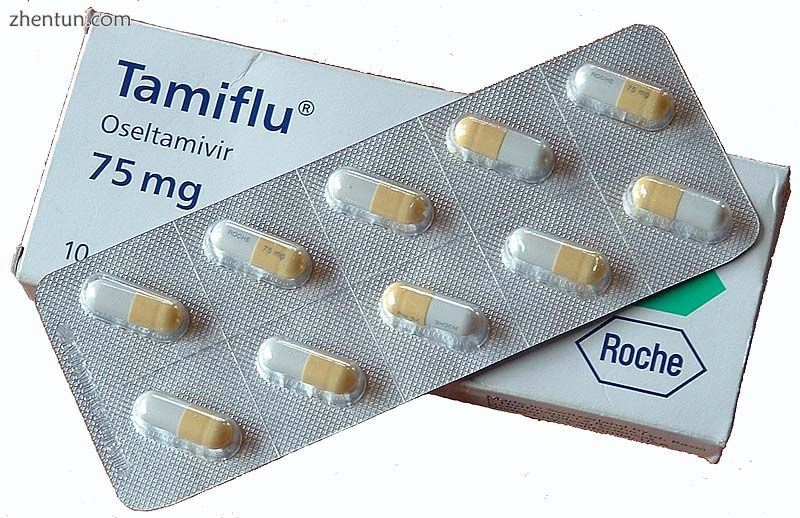
一包胶囊
与奥司他韦治疗相关的常见药物不良反应(ADR)(发生率超过1%)包括恶心和呕吐。在成人中,奥司他韦增加了恶心的风险,为此需要伤害的数字为28,而呕吐为22。因此,在奥司他韦上每22名成年人中就有1人经历了呕吐。在儿童治疗中,奥司他韦也引起呕吐。伤害所需的数字为19。因此,每19名服用奥司他韦的儿童都会呕吐。在预防中,头痛,肾脏和精神病事件更多。奥司他韦对心脏的作用尚不清楚:它可以减轻心脏症状,但也可能引起严重的心律不齐。[27]
上市后的报道包括肝炎和肝酶升高,皮疹,过敏反应(包括过敏反应),中毒性表皮坏死,心律异常,癫痫发作,精神错乱,糖尿病加重,出血性结肠炎和史蒂文斯-约翰逊综合征。[39] [40]
美国和欧盟的奥司他韦包装说明书中包含警告,指出在售后监测中会出现精神病影响。[41] [42]这些药物的发生率似乎较低,并且尚未证实奥司他韦的致病作用。[42] [43] 2014年《 Cochrane评论》发现了对精神病事件的剂量反应效应。在成人预防试验中,每治疗94人中有1人受到伤害。[27]被引用次数最多的两项奥司他韦的治疗试验均未报告任何可归因于药物的严重不良事件。[41]
在美国,它是妊娠C类,在澳大利亚是B类,这意味着少数妇女没有问题的征兆,在动物研究中,它看起来是安全的。[22] [44]肾脏疾病患者可能需要调整剂量。[3]
作用机理
奥瑟他韦是神经氨酸酶抑制剂,是流感神经氨酸酶的竞争性抑制剂。该酶裂解在人细胞表面糖蛋白上发现的唾液酸,这有助于新的病毒体离开细胞。因此,奥司他韦可防止新的病毒颗粒被释放。[22]
赋予抗性的绝大多数突变是神经氨酸酶中****的单个氨基酸残基取代(N1中的His274Tyr)。[45] 2011年对15项研究的荟萃分析发现,对奥司他韦耐药的合并发生率为2.6%。亚组分析在甲型流感患者中发现了更高的发病率,尤其是H1N1亚型。研究发现,大量使用奥司他韦的病人可能对奥司他韦产生耐药性,而奥司他韦耐药可能与肺炎显著相关。[45]在严重免疫功能低下的患者中,有报道称即使终止了奥司他韦治疗,耐奥司他韦(或扎那米韦)的病毒也会长期脱落。[4]
H1N1流感或“猪流感”
截至2010年12月15日,世界卫生组织(WHO)报告,在全球范围内测试的314份2009年流行的H1N1大流行流感样本显示对奥司他韦具有耐药性。[46]
美国疾病预防控制中心(CDC)发现,已鉴定出偶发的耐奥司他韦2009 H1N1病毒感染,包括罕见的传播受限事件,但对公共健康的影响有限。这些零星的耐药性病例是在奥司他韦治疗期间免疫抑制的患者和接受奥司他韦化学预防治疗时患病的人中发现的。[47]
2011年,在新加坡超过10%的社区标本和澳大利亚北部超过30%的标本中发现了一种新的甲型H1N1)2009流感病毒变种,其奥司他韦(和扎那米韦)的敏感性略有降低。[48]
尽管人们担心由于无法降低病毒载量而在血液系统恶性肿瘤患者中可能产生抗病毒耐药性,但一些监测研究发现,在这些患者中服用奥司他韦后耐奥司他韦pH1N1耐药,但截至2013年11月,耐奥司他韦的广泛传播未发生pH1N1。[49]
在2007-08流感季节,美国疾病预防控制中心发现H1N1样本(n = 1,020)中有10.9%具有抗药性。[50]在2008–09年度,抗性H1N1的比例增加到99.4%,而其他季节性菌株(H3N2,B)均未显示出抗性。[51]
季节性流感
从2009年到2014年,季节性流感对奥司他韦的耐药性非常低。在2010-11年度的流感季节,美国仍有99.1%的H1N1、99.8%的H3N和100%的乙型流感病毒对奥司他韦敏感。[52] 2012年1月,美国和欧洲疾病预防控制中心报告,自2011年10月以来测试的所有季节性流感样本均对奥司他韦易感。[53] [54]在2013-14年度,只有1%的2009 H1N1病毒显示出对奥司他韦的耐药性。没有其他流感病毒对奥司他韦有抗药性。[55]
H3N2
三项研究发现0%,3.3%和18%的受试者有抗药性。[45]在抵抗率为18%的研究中,受试者为儿童,其中许多人以前未曾感染过流感,因此免疫反应较弱。结果表明,在这类人群中可能需要更高和更早的剂量。[56]
乙型流感
2007年,日本研究人员在未经这些药物治疗的个体中检测到了耐神经氨酸酶B型流感病毒株。患病率为1.7%。[57]根据美国疾病预防控制中心(CDC)的数据,截至2019年,极少出现从耐奥司他韦的乙型流感病毒株传播的情况。 [58]
H5N1禽流感“禽流感”
截至2013年,在从用奥司他韦治疗的感染患者中分离出的一些H5N1分离株中,已经鉴定出赋予奥司他韦抗性的H274Y和N294S突变,并在埃及自发出现。[59]
H7N9禽流感
截至2013年,感染A(H7N9)并接受奥司他韦治疗的14名成年人中,有2人开发出了具有Arg292Lys突变的奥司他韦耐药病毒。[60]
药代动力学
它的口服生物利用度超过80%,并在首次通过肝脏后被广泛代谢为活性形式。[2] 它的分配量为23–26升。[2] 它的半衰期约为1-3小时,其活性羧酸酯代谢物的半衰期为6-10个小时。[2] 尿液中超过90%的口服剂量作为活性代谢物被消除。[2]
历史
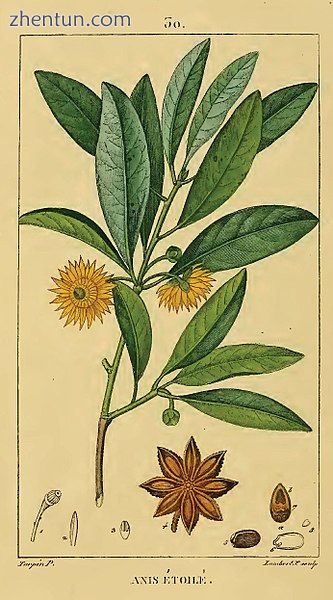
弗朗索瓦·皮埃尔·乔梅顿1833年创作的《 Flore Medicale》
吉列德科学公司的科学家使用莽草酸作为合成的起点发现了奥司他韦。 莽草酸最初仅作为中国八角茴香的提取物获得;但到2006年,其中30%的供应是通过大肠杆菌重组生产的。[61] [62]吉利德(Gilead)在1996年将其相关显露专有权授予罗氏(Roche)。[63]该药物的显露在泰国,菲律宾,印度尼西亚和其他几个国家没有得到保护。[63]
FDA于1999年根据两项双盲,随机,安慰剂对照的临床试验,批准了磷酸奥司他韦治疗成人流感[64]。[65] 2002年6月,欧洲药品管理局(EMA)批准了磷酸奥司他韦用于预防和治疗流感。 2003年,对十项随机临床试验的汇总分析得出结论,奥司他韦降低了下呼吸道感染的风险,从而降低了成人使用抗生素和住院的可能性。[66]
Oseltamivir(作为达菲)在2005年东南亚的H5N1禽流感流行中得到广泛使用。**为应对这一流行,各国政府(包括英国,加拿大,以色列,美国和澳大利亚的政府)库存大量大量使用奥司他韦为可能的大流行做准备[67],并且由于对库存的高需求,该药在全球范围内都短缺。[61] 2005年11月,美国总统乔治·W·布什(George W. Bush)要求国会拨款10亿美元用于生产和储存奥司他韦,此前国会已批准18亿美元用于该药的军事用途。国防部长唐纳德·拉姆斯菲尔德(Donald Rumsfeld)曾担任吉利德科学公司(Gilead Sciences)的前任主席,他撤回了政府有关该药物的所有决定。[68]
2006年,一项Cochrane评论(自撤回以来)提出了一个争议,认为奥司他韦的有效性不佳,因此不应在常规季节性流感期间使用。[69]
2008年12月,印度药品公司Cipla在印度法院系统中胜诉,允许其生产价格更便宜的仿制药达菲,称为Antiflu。 2009年5月,Cipla获得了世界卫生组织(WHO)的批准,证明其抗流感药物与达菲一样有效,并且抗流感药物已被列入世界卫生组织预认证的药品清单。[70]
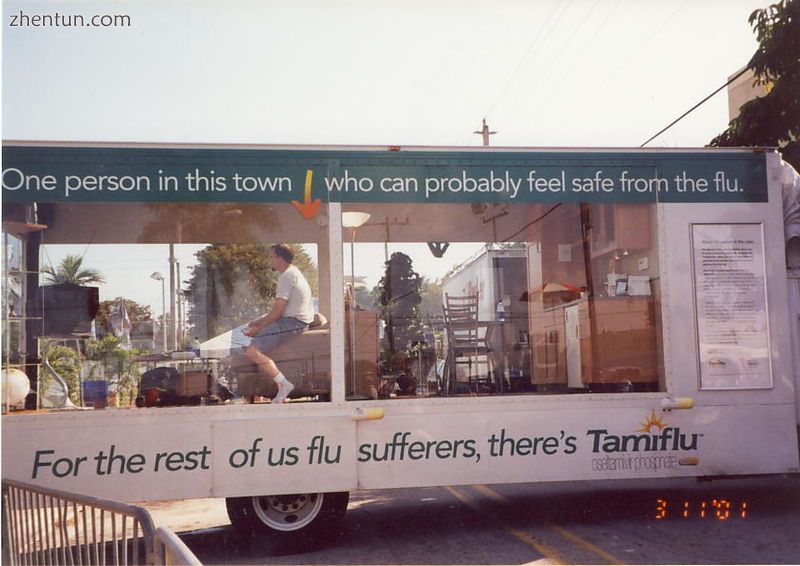
节日期间使用的营销展示以一个居住在密封环境中的人为特色
2009年,发现一种新的A / H1N1流感病毒在北美传播。 2009年6月,世界卫生组织宣布A / H1N1流感为大流行病。[71]美国国立卫生研究院(NICE),疾病预防控制中心,世界卫生组织和ECDC保留了使用奥司他韦的建议。[6] [72]
从2010年到2012年,Cochrane要求罗氏提供其试验的完整临床研究报告,但没有提供。[73] 2011年,向欧洲药品管理局(EMA)提出的信息自由要求为Cochrane提供了16项罗氏奥司他韦的临床试验报告。 2012年,Cochrane团队根据这些报告发表了中期评估。 2013年,GSK发布了扎那米韦研究数据后,罗氏发布了74份奥司他韦临床试验的完整临床研究报告。[74] 2014年,Cochrane仅根据完整的临床研究报告和法规文件发表了更新的评论。[27] [73] 2016年,罗氏的奥司他韦显露开始失效。[63]
兽医用途
有[何时]关于奥司他韦降低犬细小病毒感染的疾病严重程度和住院时间的报道。[75]该药物可能会限制病毒侵入小肠隐窝细胞的能力,并降低胃肠道细菌的定殖和毒素产生。[76]
另见
Amantadine and rimantadine – M2 inhibitors, for influenza treatment
Baloxavir marboxil, an endonuclease inhibitor, for influenza treatment
参考
"Oseltamivir (Tamiflu) Use During Pregnancy". Drugs. Archived from the original on 9 September 2017. Retrieved 16 January 2017.
Davies BE (April 2010). "Pharmacokinetics of oseltamivir: an oral antiviral for the treatment and prophylaxis of influenza in diverse populations". The Journal of Antimicrobial Chemotherapy. 65 Suppl 2: ii5–ii10. doi:10.1093/jac/dkq015. PMC 2835511. PMID 20215135.
"Oseltamivir Phosphate Monograph for Professionals". The American Society of Health-System Pharmacists. Archived from the original on 13 May 2016. Retrieved 8 January 2017.
"CDC Recommendations for Influenza Antiviral Medications Remain Unchanged". U.S. Centers for Disease Control and Prevention (CDC). 10 April 2014. Archived from the original on 18 January 2017. Retrieved 16 January 2017.
European Centre for Disease Prevention and Control (2 June 2014). "New and updated evaluations of neuraminidase inhibitors for preventing and treating influenza published". Archived from the original on 2014-11-02.
"Amantadine, oseltamivir and zanamivir for the treatment of influenza". National Institute for Health and Care Excellence (NICE). 25 February 2009. Archived from the original on 18 January 2017. Retrieved 16 January 2017.
"IDSA Continues to Recommend Antivirals for Influenza". Archived from the original on 24 April 2014. Retrieved 24 April 2014.
Brownlee S (19 February 2013). "Tamiflu: Myth and Misconception". The Atlantic. Archived from the original on 29 December 2014. Retrieved 7 December 2014.
Butler D (April 2014). "Tamiflu report comes under fire". Nature. 508 (7497): 439–40. Bibcode:2014Natur.508..439B. doi:10.1038/508439a. PMID 24759392.
Michiels B, Van Puyenbroeck K, Verhoeven V, Vermeire E, Coenen S (2013). Jefferson T (ed.). "The value of neuraminidase inhibitors for the prevention and treatment of seasonal influenza: a systematic review of systematic reviews". PLOS ONE. 8 (4): e60348. Bibcode:2013PLoSO...860348M. doi:10.1371/journal.pone.0060348. PMC 3614893. PMID 23565231.
Ebell MH, Call M, Shinholser J (April 2013). "Effectiveness of oseltamivir in adults: a meta-analysis of published and unpublished clinical trials". Family Practice. 30 (2): 125–33. doi:10.1093/fampra/cms059. PMID 22997224.
Okoli GN, Otete HE, Beck CR, Nguyen-Van-Tam JS (9 December 2014). "Use of neuraminidase inhibitors for rapid containment of influenza: a systematic review and meta-analysis of individual and household transmission studies". PLOS ONE. 9 (12): e113633. Bibcode:2014PLoSO...9k3633O. doi:10.1371/journal.pone.0113633. PMC 4260958. PMID 25490762.
Wang K, Shun-Shin M, Gill P, Perera R, Harnden A (April 2012). Harnden A (ed.). "Neuraminidase inhibitors for preventing and treating influenza in children (published trials only)". The Cochrane Database of Systematic Reviews. 4 (4): CD002744. doi:10.1002/14651858.CD002744.pub4. PMC 6599832. PMID 22513907.
Jefferson T, Jones M, Doshi P, Spencer EA, Onakpoya I, Heneghan CJ (April 2014). "Oseltamivir for influenza in adults and children: systematic review of clinical study reports and summary of regulatory comments". BMJ. 348: g2545. doi:10.1136/bmj.g2545. PMC 3981975. PMID 24811411.
Agrawal R, Rewatkar PV, Kokil GR, Verma A, Kalra A (July 2010). "Oseltamivir: a first line defense against swine flu". Medicinal Chemistry. 6 (4): 247–51. doi:10.2174/1573406411006040247. PMID 20843284.
World Health Organization (2019). World Health Organization model list of essential medicines: 21st list 2019. Geneva: World Health Organization. hdl:10665/325771. WHO/MVP/EMP/IAU/2019.06. License: CC BY-NC-SA 3.0 IGO.
"The FDA approves first generic version of widely used influenza drug, Tamiflu". U.S. Food and Drug Administration (FDA). 4 August 2016. Archived from the original on 8 August 2016. Retrieved 6 August 2016.
"Drugs@FDA: FDA-Approved Drugs". U.S. Food and Drug Administration (FDA). Retrieved 9 January 2020.
"Oseltamivir". International Drug Price Indicator Guide. Retrieved 30 July 2016.
"NADAC as of 2019-02-27". Centers for Medicare & Medicaid Services (CMS). Retrieved 3 March 2019.
"The Top 300 of 2019". clincalc. Retrieved 22 December 2018.
"Tamiflu- oseltamivir phosphate capsule Tamiflu- oseltamivir phosphate powder, for suspension". DailyMed. 15 November 2019. Retrieved 30 January 2020.
Kmietowicz Z (June 2017). "WHO downgrades oseltamivir on drugs list after reviewing evidence". BMJ. 357: j2841. doi:10.1136/bmj.j2841. PMID 28607038.
"Influenza Antiviral Medications: Summary for Clinicians". U.S. Centers for Disease Control and Prevention (CDC). 3 December 2014. Archived from the original on 13 December 2014. Retrieved 9 December 2014.
Committee On Infectious Diseases (November 2014). "Recommendations for prevention and control of influenza in children, 2014-2015". Pediatrics. 134 (5): e1503-19. doi:10.1542/peds.2014-2413. PMID 25246619.
Public Health England (November 2014). "The use of antivirals for the treatment and prophylaxis of influenza: PHE summary of current guidance for healthcare professionals" (PDF). Archived (PDF) from the original on 2014-12-08.
Jefferson T, Jones MA, Doshi P, Del Mar CB, Hama R, Thompson MJ, et al. (April 2014). "Neuraminidase inhibitors for preventing and treating influenza in healthy adults and children". The Cochrane Database of Systematic Reviews. 4 (4): CD008965. doi:10.1002/14651858.CD008965.pub4. PMC 6464969. PMID 24718923.
"Researchers, regulators and Roche row over stockpiled drug Tamiflu". Reuters. Archived from the original on 2015-09-24.
Musher DM, Thorner AR (October 2014). "Community-acquired pneumonia". New England Journal of Medicine. 371 (17): 1619–28. doi:10.1056/NEJMra1312885. PMID 25337751.
Qiu S, Shen Y, Pan H, Wang J, Zhang Q (2015). "Effectiveness and safety of oseltamivir for treating influenza: an updated meta-analysis of clinical trials". Infectious Diseases. 47 (11): 808–19. doi:10.3109/23744235.2015.1067369. PMID 26173991.
Heneghan CJ, Onakpoya I, Jones MA, Doshi P, Del Mar CB, Hama R, et al. (May 2016). "Neuraminidase inhibitors for influenza: a systematic review and meta-analysis of regulatory and mortality data". Health Technology Assessment. 20 (42): 1–242. doi:10.3310/hta20420. PMC 4904189. PMID 27246259.
Malosh RE, Martin ET, Heikkinen T, Brooks WA, Whitley RJ, Monto AS (May 2018). "Efficacy and Safety of Oseltamivir in Children: Systematic Review and Individual Patient Data Meta-analysis of Randomized Controlled Trials". Clinical Infectious Diseases. 66 (10): 1492–1500. doi:10.1093/cid/cix1040. PMID 29186364.
Holzinger F, Beck S, Dini L, St**ter C, Heintze C (May 2014). "The diagnosis and treatment of acute cough in adults". Deutsches Arzteblatt International. 111 (20): 356–63. doi:10.3238/arztebl.2014.0356. PMC 4047603. PMID 24882627.
Hernán MA, Lipsitch M (August 2011). "Oseltamivir and risk of lower respiratory tract complications in 病人 with flu symptoms: a meta-analysis of eleven randomized clinical trials". Clinical Infectious Diseases. 53 (3): 277–9. doi:10.1093/cid/cir400. PMC 3137795. PMID 21677258.
Dobson J, Whitley RJ, Pocock S, Monto AS (May 2015). "Oseltamivir treatment for influenza in adults: a meta-analysis of randomised controlled trials". Lancet. 385 (9979): 1729–37. doi:10.1016/S0140-6736(14)62449-1. PMID 25640810.
Burch J, Corbett M, Stock C, Nicholson K, Elliot AJ, Duffy S, et al. (September 2009). "Prescription of anti-influenza drugs for healthy adults: a systematic review and meta-analysis". The Lancet. Infectious Diseases. 9 (9): 537–45. doi:10.1016/S1473-3099(09)70199-9. PMID 19665930.
"Drug Approval Package: Tamiflu (Oseltamivir Phosphate) NDA# 021087". 30 March 2001. Archived from the original on 2014-04-16.
Jackson RJ, Cooper KL, Tappenden P, Rees A, Simpson EL, Read RC, Nicholson KG (January 2011). "Oseltamivir, zanamivir and amantadine in the prevention of influenza: a systematic review". The Journal of Infection. 62 (1): 14–25. doi:10.1016/j.jinf.2010.10.003. PMID 20950645.
"Roche – Doing now what 病人 need next" (PDF). Archived from the original (PDF) on 2005-11-03.
Rossi S, editor. Australian Medicines Handbook 2006. Adelaide: Australian Medicines Handbook; 2006.
Cohen D (9 April 2014). "Oseltamivir: another case of regulatory failure?". BMJ. 348 (apr09 8): g2591. doi:10.1136/bmj.g2591.
"Pediatric safety update for Tamiflu" Archived 2007-09-27 at the Wayback Machine. U.S. Food and Drug Administration (FDA)
Waknine Y (2006). "Tamiflu May Be Linked to Risk for Self-Injury and 谵妄". Medscape. Archived from the original on 25 November 2011. Retrieved 17 May 2008.
"Prescribing medicines in pregnancy database". Australian Government. 3 March 2014. Archived from the original on 8 April 2014. Retrieved 22 April 2014.
Thorlund K, Awad T, Boivin G, Thabane L (May 2011). "Systematic review of influenza resistance to the neuraminidase inhibitors". BMC Infectious Diseases. 11 (1): 134. doi:10.1186/1471-2334-11-134. PMC 3123567. PMID 21592407.
"Update on oseltamivir resistance to influenza H1N1 (2009) viruses" (PDF). World Health Organization (WHO). 15 December 2010. Archived (PDF) from the original on 27 January 2011. Retrieved 30 December 2010.
"Antiviral Drug Resistance among Influenza Viruses Guidance on the Use of Influenza Antiviral Agents (Current for the 2013–14 Influenza Season)". U.S. Centers for Disease Control and Prevention (CDC). Archived from the original on 13 February 2014. Retrieved 21 April 2014.
Hurt AC (9 June 2011). "Increased detection in Australia and Singapore of a novel influenza A(H1N1)2009 variant with reduced oseltamivir and zanamivir sensitivity due to a S247N neuraminidase mutation". Eurosurveillance. Archived from the original on 23 April 2014.
Downing M (November 2013). "Antiviral Therapy for Pandemic Influenza A (H1N1) Infection: Dosing, Combination Therapy, and Resistance" (PDF). National collaborating centre for infectious diseases. Archived (PDF) from the original on 2014-04-19.
"2007–08 U.S. Influenza Season Summary". U.S. Centers for Disease Control and Prevention (CDC). Archived from the original on 2011-10-20.
"Influenza (Flu) – Weekly Report: Influenza Summary Update Week 53, 2008-2009 Season". Archived from the original on 2011-10-20.
"2010-2011 Influenza Season Summary". U.S. Centers for Disease Control and Prevention (CDC). Archived from the original on 2012-01-25.
"2011-2012 Influenza Season Week 51 ending December 24, 2011". U.S. Centers for Disease Control and Prevention (CDC). Archived from the original on 2013-05-17.
"Main surveillance developments in week 51/2011 (19–25 December 2011)" (PDF). European Centre for Disease Prevention and Control (ECDC). January 2012. Archived (PDF) from the original on 2012-06-10.
"CDC Influenza Division Key Points, March 28, 2014" (PDF). U.S. Centers for Disease Control and Prevention (CDC). 28 March 2014. Archived from the original (PDF) on 2 April 2014. Retrieved 15 April 2014.
Ward P, Small I, Smith J, Suter P, Dutkowski R (February 2005). "Oseltamivir (Tamiflu) and its potential for use in the event of an influenza pandemic". The Journal of Antimicrobial Chemotherapy. 55 Suppl 1: i5–i21. doi:10.1093/jac/dki018. PMID 15709056.
Hatakeyama S, Sugaya N, Ito M, Yamazaki M, Ichikawa M, Kimura K, et al. (April 2007). "Emergence of influenza B viruses with reduced sensitivity to neuraminidase inhibitors". JAMA. 297 (13): 1435–42. doi:10.1001/jama.297.13.1435. PMID 17405969.
"Antiviral Drug Resistance among Influenza Viruses". U.S. Centers for Disease Control and Prevention (CDC). 2019-04-17. Retrieved 2020-01-29.
McKimm-Breschkin JL (January 2013). "Influenza neuraminidase inhibitors: antiviral action and mechanisms of resistance". Influenza and Other Respiratory Viruses. 7 Suppl 1: 25–36. doi:10.1111/irv.12047. PMC 4942987. PMID 23279894.
Hay AJ, Hayden FG (June 2013). "Oseltamivir resistance during treatment of H7N9 infection". Lancet. 381 (9885): 2230–2. doi:10.1016/S0140-6736(13)61209-X. PMID 23809549.
Farina V, Brown JD (November 2006). "Tamiflu: the supply problem". Angewandte Chemie. 45 (44): 7330–4. doi:10.1002/anie.200602623. PMID 17051628.
Rawat G, Tripathi P, Saxena RK (May 2013). "Expanding horizons of shikimic acid. Recent progresses in production and its endless frontiers in application and market trends". Applied Microbiology and Biotechnology. 97 (10): 4277–87. doi:10.1007/s00253-013-4840-y. PMID 23553030.
WIPO April 2006 Avian Flu Drugs: Patent Questions Archived 2009-12-08 at the Wayback Machine
"Drug Approval Package: Tamiflu (Oseltamivir Phosphate) NDA# 021087". U.S. Food and Drug Administration (FDA). 24 December 1999. Archived from the original on 9 January 2020. Retrieved 9 January 2020.
FDA Medical Review Archived 2014-04-16 at the Wayback Machine, linked from Tamiflu Drug Approval Package Archived 2014-04-16 at the Wayback Machine
Kaiser L, Wat C, Mills T, Mahoney P, Ward P, Hayden F (July 2003). "Impact of oseltamivir treatment on influenza-related lower respiratory tract complications and hospitalizations". Archives of Internal Medicine. 163 (14): 1667–72. doi:10.1001/archinte.163.14.1667. PMID 12885681.
Heiberg M (14 October 2005). "Oseltamivir-resistant H5N1 virus isolated from Vietnamese girl". University of Minnesota. Archived from the original on 14 December 2014. Retrieved 7 December 2014.
Shannon Brownlee and Jeanne Lenzer (November 2009) "Does the Vaccine Matter?" Archived 2010-01-04 at the Wayback Machine, The Atlantic
Jefferson TO, Demicheli V, Di Pietrantonj C, Jones M, Rivetti D (July 2006). "Neuraminidase inhibitors for preventing and treating influenza in healthy adults" (PDF). The Cochrane Database of Systematic Reviews (3): CD001265. doi:10.1002/14651858.CD001265.pub2. PMID 16855962.{{ (Retracted, see doi:10.1002/14651858.cd001265.pub3)
"Cipla's anti-flu drug gets nod". Times of India. 2009-05-14. Archived from the original on 2012-10-23. Retrieved 2009-07-29.
Jefferson T, Doshi P (April 2014). "Multisystem failure: the story of anti-influenza drugs". BMJ. 348 (apr10 14): g2263. doi:10.1136/bmj.g2263. PMID 24721793.
"WHO Guidelines for Pharmacological Management of Pandemic Influenza A(H1N1) 2009 and other Influenza Viruses Revised February 2010" (PDF). WHO. Archived (PDF) from the original on 2013-10-27.
"Tamiflu campaign". BMJ. Retrieved 21 January 2020.
Cohen, D. (April 4, 2013). "Roche offers researchers access to all Tamiflu trials". BMJ. 346 (apr04 3): f2157–f2157. doi:10.1136/bmj.f2157. ISSN 1756-1833.
Savigny MR, Macintire DK (February 2010). "Use of oseltamivir in the treatment of canine parvoviral enteritis". Journal of Veterinary Emergency and Critical Care. 20 (1): 132–42. doi:10.1111/j.1476-4431.2009.00404.x. PMID 20230441.
Macintire, Douglass K. (2006). "Treatment of Parvoviral Enteritis". Proceedings of the Western Veterinary Conference. Retrieved 2007-06-09. |